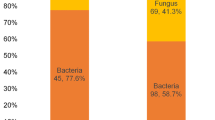Abstract
Aim and Objectives
Mycotic keratitis, with its diverse clinical presentation and difficulties in treatment, makes it a challenging task for clinicians and an important object of study. The aim of present study was to determine the frequency of occurrence and epidemiological association with identification of fungal isolates from mycotic keratitis cases.
Materials and Methods
This was a prospective and observational study conducted in Mycology Laboratory, Department of Microbiology, S.P. Medical College, Bikaner, on corneal scrapings and swabs of a total of 480 patients attending the Ophthalmology OPD, P.B.M. Hospital, Bikaner, during July 2005 to June 2012.
Results
Out of 480 suspected cases, 180 were found to be positive for fungus by smear/culture examination. Increased incidence was seen in the months of May to September with Aspergillus fumigatus being the most common isolate.
Conclusion
Mycotic keratitis, though an age-old disease, still presented with challenging aspects of diagnosis and treatment. The study showed fungal keratitis is prevalent in rural parts of north-west Rajasthan, mainly found in males (age group 21–40 years) with low socio-economic status (farm or factory workers). The most common cause of fungal keratitis was found to be species of Aspergillus.





Similar content being viewed by others
References
Pascolini D, Mariotti SP. Global estimates of visual impairment: 2010. Br J Ophthalmol. 2012;96(5):614–8.
Gupta N, Tandon R, Gupta SK, Sreenivas V, Vashist P. Burden of corneal blindness in India. Indian J Community Med. 2013;38(4):198–206.
National Programme for Control of Blindness (NPCB), Directorate General of Health Services, Ministry of Health and Family Welfare, Government of India. 1976. http://npcb.nic.in/.
Kindo AJ, Anita S, Kalpana S. Nattrassia mangiferae causing fungal keratitis. Indian J Med Microbiol. 2010;28(2):178–81.
Ajello L, Wilson LA. Agents of Oculomycosis. Fungal infections of the eye. In: Collier L, Balows A, Sussman M, editors. Topley and Wilsons microbiology and microbial infections. 9th ed. New York: Oxford University Press Inc.; 1998. p. 533–4.
Basak SK, Dasgupta LR, Gupta AK, Ghosh RB. Mycological studies in keratitis. Indian J Med Res. 2005;61:165–8.
Chowdhary A, Singh K. Spectrum of fungal keratitis in North India. Cornea. 2005;24(1):8–15.
Rosa RH, Miller D, Alfonso EC. The changing spectrum of fungal keratitis in South Florida. Ophthalmology. 1994;101(6):1005–13.
Yusuf N. Microbial keratitis in kingdom of Bahrain: clinical and Microbiological Study. Middle East Afr J Ophthalmol. 2009;16(1):3–7.
CDC Laboratory manual for medical mycology, U.S. department of health, education and welfare public health service, 1963. A-15 to A-16.
Gopinathan U, Sharma S, Garg P, Rao GN. Review of epidemiological, microbiological diagnosis and treatment outcome of microbial keratitis: experience of over a decade. Indian J Ophthalmol. 2009;57:273–9.
Kumari N, Xess A, Shahi SK. Study of keratomycosis: our experience. Indian J Pathol Microbiol. 2002;45(3):299–302.
Bharathi MJ, Ramakrishnan R, et al. Epidemiological characteristics and laboratory diagnosis of fungal keratitis. Indian J Ophthalmol. 2003;51:315–21.
Saha R, Das S. Study of bipolaris keratomycosis. Mycoses. 2005;48(6):453–5.
Chander J, Sharma A. Prevalence of fungal corneal ulcers in North India. Infection. 1994;22:207–9.
Deshpande SD, Koppikar GV. A study of mycotic keratitis in Mumbai. Indian J Pathol Microbiol. 1999;42(1):81–7.
Rautaraya B, Sharma S, Kar S. Diagnosis and treatment outcome of mycotic keratitis at a tertiary eye care centre in eastern India. BMC Ophthalmol. 2011;11:39.
Khorgade RR, Gaikwad AA, Nilekar SL, Kulkarni DM. Mycotic keratitis in patients attending a tertiary care hospital. Int J Curr Microbiol Appl Sci. 2015;4(9):428–37. http://www.ijcmas.com/Archives-34.php.
Author information
Authors and Affiliations
Corresponding author
Rights and permissions
About this article
Cite this article
Binnani, A., Gupta, P.S. & Gupta, A. Epidemio-Clinico-Microbiological Study of Mycotic Keratitis in North-West Region of Rajasthan. Mycopathologia 183, 717–722 (2018). https://doi.org/10.1007/s11046-016-0102-8
Received:
Accepted:
Published:
Issue Date:
DOI: https://doi.org/10.1007/s11046-016-0102-8




